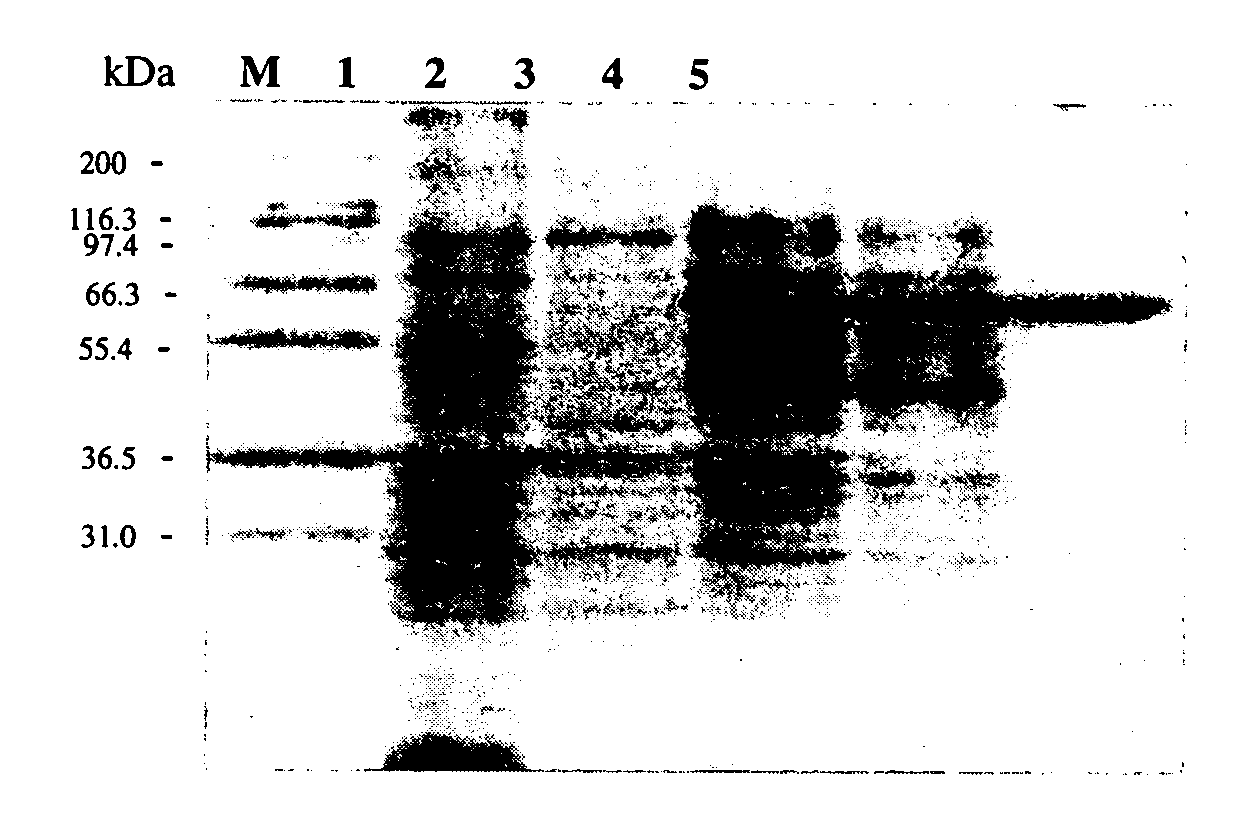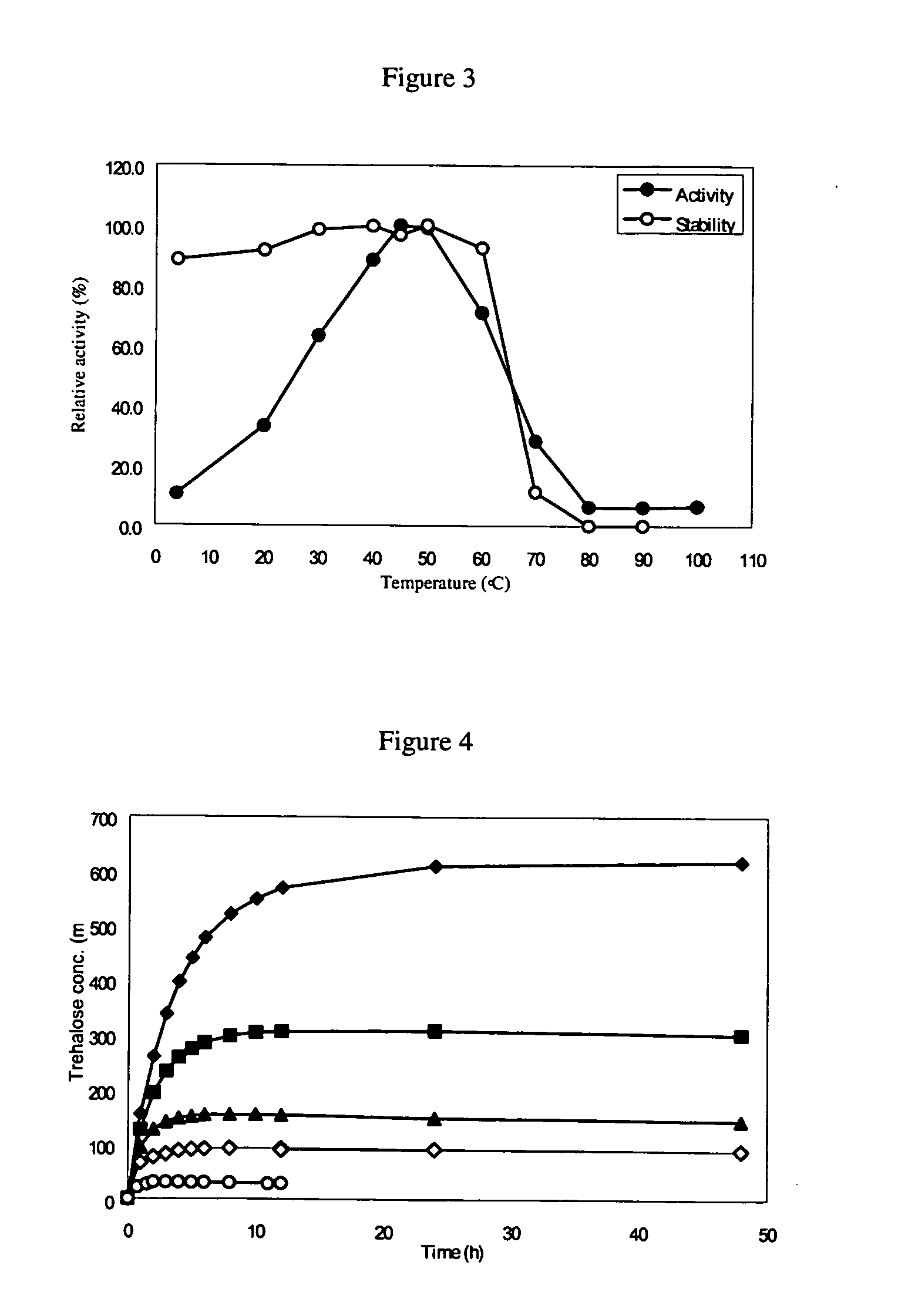Novel trehalose synthase from Picrophilus torridus and methods of use thereof
a trehalose synthase, acid and heat resistant technology, applied in the field of trehalose synthase enzymes, can solve the problems of low enzyme yield in the original organism, preventing the use of these enzymes in even slightly acidic environments, low tolerance to heat and acidity, etc., and achieves reliable and cost-effective production of trehalose, high activity and stability
- Summary
- Abstract
- Description
- Claims
- Application Information
AI Technical Summary
Benefits of technology
Problems solved by technology
Method used
Image
Examples
example 1
[0148]Synthesis of Trehalose Synthase Gene. According to the published DNA sequence of the trehalose synthase gene of Picrophilus torridus (DSM 9790) (GenBank accession number AE017261) (PTTS) (24), 36 oligonucleotides were designed accounting for both strands of the full-length ORF of PTTS (1677 bp). Each oligonucleotide contained 70 base pairs and overlapped with adjacent ones by 20 base pairs. NdeI and EcoRI cutting sites were introduced into the 5′ and 3′ ends of the gene, respectively, and the three NdeI cutting sites inside the sequence were modified according to the E. coli codon usage database (at Website http: / / www.kazusa.or.jp / codon) without changing the amino acid sequence. The stop codon of PTTS was eliminated in order to in-frame read a His(6)-tag on the C terminal of the protein for one-step purification. Overlap extension PCR was used to assemble the 36 oligonucleotides to obtain the full-length PTTS gene. The synthesized PTTS gene were then digested with restriction ...
example 2
[0149]Protein Purification. The strain harboring the plasmid was cultivated overnight in LB-Amp-Kan-Tet-Chl medium and refreshed in a ratio of 1:40 with the same medium. Protein expression was performed by using basal-level expression and the refreshed culture was cultivated at 27° C. and in an orbital shaker at a speed of 225 rpm for two days without the addition of IPTG. The culture broth was centrifuged at 4000 rpm for 10 min at 4° C. and the supernatant was decanted. The resulting cell pellet was resuspended in 20 mM sodium phosphate buffer (pH 7.0), and cells were lysed using a sonicator (Misonix, model XL-2020) set to power of 5% for 20 times of 30 s bursts, with a 30 s intermission between each burst. After centrifugation at 12000 rpm for 20 min, the supernatant containing crude enzyme was collected and then purified according to the following procedures: 20 mM sodium phosphate (pH 7.0) buffer containing 2.5 M NaCl and 25 mM imidazole was added to the crude extract to reach a...
example 3
[0150]Protein Assay. Protein concentration was measured by the method of Bradford using a protein assay kit purchased from Bio-Rad Lab (Hercules, Calif.) with bovine serum albumin as standard.
PUM
| Property | Measurement | Unit |
|---|---|---|
| pH | aaaaa | aaaaa |
| temperature | aaaaa | aaaaa |
| temperatures | aaaaa | aaaaa |
Abstract
Description
Claims
Application Information
 Login to View More
Login to View More - R&D
- Intellectual Property
- Life Sciences
- Materials
- Tech Scout
- Unparalleled Data Quality
- Higher Quality Content
- 60% Fewer Hallucinations
Browse by: Latest US Patents, China's latest patents, Technical Efficacy Thesaurus, Application Domain, Technology Topic, Popular Technical Reports.
© 2025 PatSnap. All rights reserved.Legal|Privacy policy|Modern Slavery Act Transparency Statement|Sitemap|About US| Contact US: help@patsnap.com



